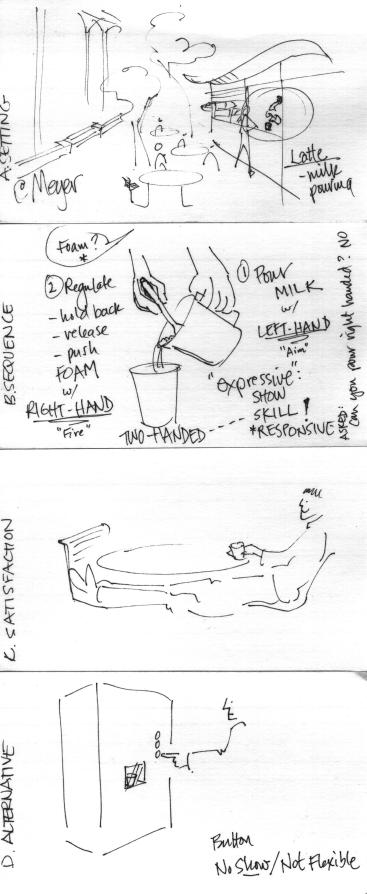Difference between revisions of "250A 2013 HW 2"
From CCRMA Wiki
| Line 1: | Line 1: | ||
| − | <font size=5>PART 1: Buttons vs. Handles | + | <font size=5>DUE MONDAY 10/7 </font> |
| + | |||
| + | |||
| + | <font size=5>PART 1: Buttons vs. Handles </font> | ||
by Bill Verplank | by Bill Verplank | ||
| Line 20: | Line 23: | ||
| − | <font size=5>Part 2 - Expressive Scenarios | + | <font size=5>Part 2 - Expressive Scenarios </font><br> |
{| | {| | ||
| Line 44: | Line 47: | ||
| − | <font size=5>PART 3: Reading | + | <font size=5>PART 3: Reading </font> |
Latest revision as of 04:16, 2 October 2013
DUE MONDAY 10/7
PART 1: Buttons vs. Handles
by Bill Verplank
- One way to distinguish the ways we DO things is with HANDLES or BUTTONS.
- Buttons are discrete, handles continuous. With a button you initiate and let go; with a handle you grab on and contol. Button clicks are more likely symbolic - we string them together. Handles are more analogic - we gesture and indicate.
- Bring to class two sketches (8-1/2 x 11); one of a ``handle one of a ``button".
- Sketch enough of the context so it is clear where and who might use it.
- List the features that make this a good or bad example - what you like or don't.
- Tips:
- You will present these to everyone in the class. Use a Sharpie.
- The drawing should be self-explanatory. Use as few words as possible.
- Make it clear how the user interacts with it. Where are the user's hands?
Part 2 - Expressive Scenarios
PART 3: Reading
1 - Contexts of Collaborative Musical Experience
http://www.nime.org/proceedings/2003/nime2003_129.pdf
2 - Multi-user Instruments: Models, Examples and Promises
